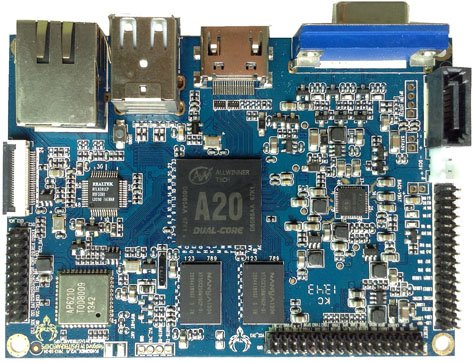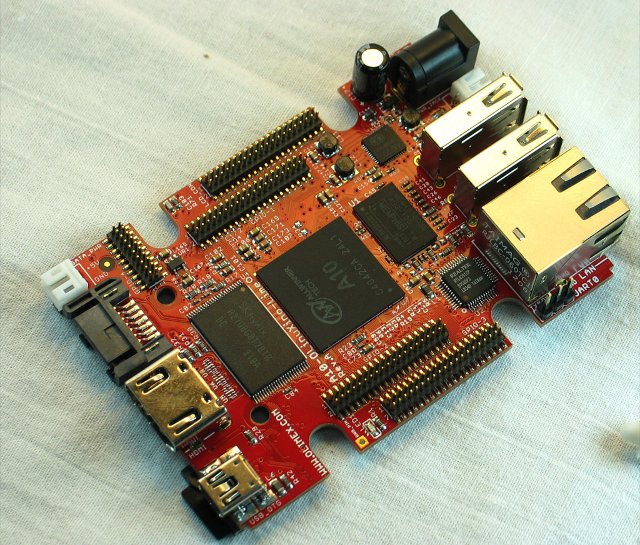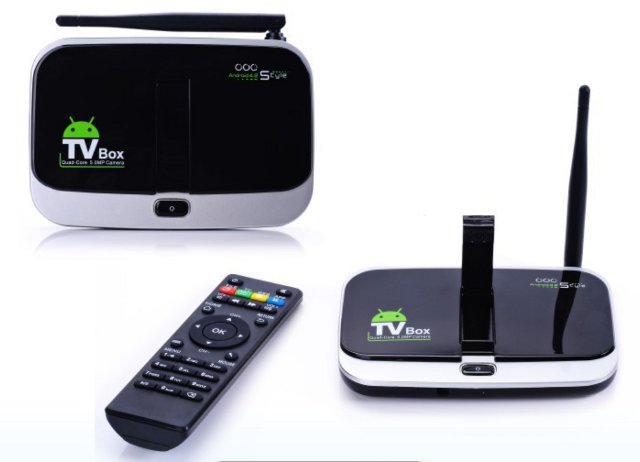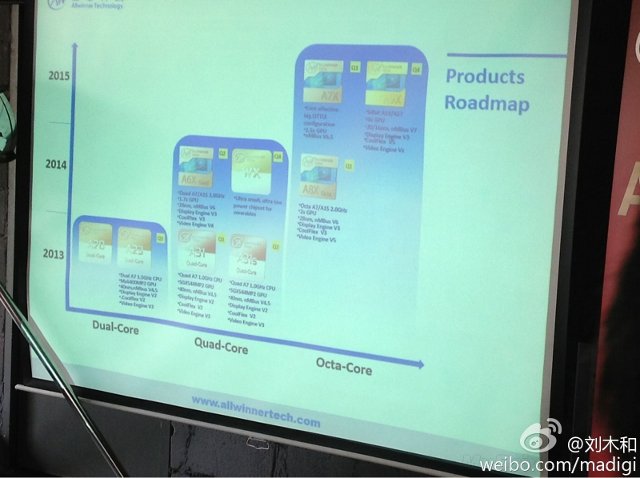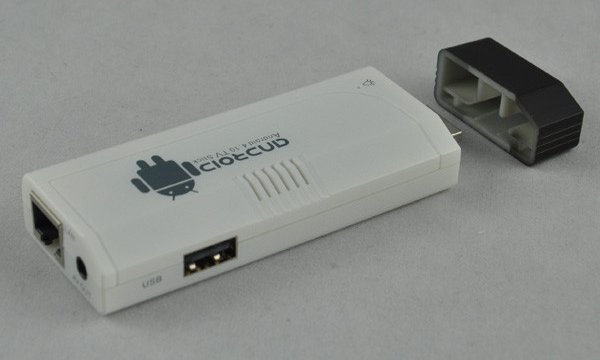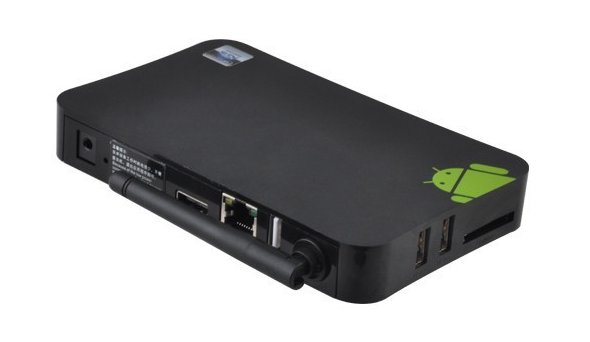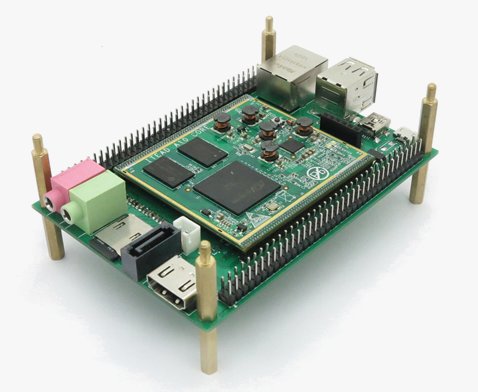Anichips Technology, a Shenzhen based electronics design company, has just announced PhoenixA20, a pico-ITX board features AllWinner A20 dual core Cortex A20 SoC with 1GB, 4GB Flash, HDMI and VGA output, Ethernet, and built-in Wi-fi and Bluetooth. PhoenixA20 specifications: SoC- AllWinner A20 dual ARM Cortex-A7 processor @ 1.2 GHz with ARM Mali-400MP2 GPU System Memory – 1GB DDR3 Storage – 4GB NAND Flash, micro SD card slot (up to 32GB), and SATA Video output – HDMI and VGA connectors. LVDS, RGB and CVBS signals are accessible via the expansion headers Connectivity – 10/100M Ethernet, Wi-Fi & Bluetooth 4.0 (via AP6210) USB – 2x USB 2.0 host ports Camera Interface – CSI Expansion headers – 3x UART, 2x I2C, 1×I2S, 1xCVBS, 4x TVIN, 2x Line IN, 1x SPDIF, 2x PWM, 2x LRADC, 2x FMIN, 1xHeadphone, 4xTVOUT, MIC, IR, TP The board supports Android 4.2.2, and Linux 3.3 with source code for […]
Olimex Announces 30 Euros A10-OLinuXino-LIME Development Board for December
The Raspberry Pi, Beaglebone Black and Cubieboard are probably the best selling ARM Linux boards in the sub $50 category, but they’ll soon be joined by Olimex A10-OLinuXino-LIME powered by AllWinner A10 ARM Cortex A8 SoC with 512MB RAM that will sell for 30 Euros (About $40) when it becomes available in December. Another version of the board based on AllWinner A20 dual core Cortex A7 SoC, called A20-OLinuXino-LIME will also be sold, adding Gigabit Ethernet, and scheduled for Q1 2014. Pricing has yet to be disclosed for the A20 version. A10-OLinuXino-LIME specifications: SoC – AllWinner A10 ARM Cortex-A8 @ 1GHz with Mali-400 GPU System Memory – 512MB DDR3 Storage – microSD card slot, SATA, and optional 4GB NAND Flash Video Output – HDMI 1080p USB – USB-OTG + 2x USB Hosts Connectivity – 10/100Mbit Ethernet Expansions – 200 GPIOs on 0.05″ connectors Misc – Lipo battery management and connector, […]
CS918S Android STB Features AllWinner A31s Processor, a Retractable Webcam, Built-in 3G
K-R42-1, now better known as CS918, has been a fairly popular Android set-top box based on RK3188 due to its low price. There’s no a new model called CS918S with a similar casing, but replacing Rockchip RK3188, by AllWinner A31s, adding more flash (16GB), a retractable webcam, and an internal bay with an optional 3G/4G module. Here are the specs of this device: SoC – AllWinner A31s quad cortex cortex A7 processor @ 1.2 GHz + PowerVR SGX544MP2 GPU System Memory – 2GB DDR3 Storage – 16GB NAND flash + microSD card slot Video Output – HDMI and CVBS (AV) Audio Output – HDMI, optical SPDIF, and AV Video Playback / Encoding 2160p (UHD) H.264 decoding 1080p video decoding for Mpeg1/2, Mpeg4 SP/ASP GMC, H.263, H.264, etc. 1080p@30fps or 720p@60fps encoding 3840×1080@30fps 3D decoding, BD/SBS/TAB/FP supported 3840×1080@30fps 3D encoding Connectivity – Wi-Fi 802.11 b/g/n, Bluetooth 4.0 (Realtek 8723), 10/100M Ethernet, […]
AllWinner Roadmap Until 2015: A23, A6X, A7X, A8X and A9X
AllWinner has recently unveiled their products roadmap until 2015. They’ve got big.LITTLE cortex A7/A15 processors, as well as a processor for wearable planned for 2014, and a big.LITTLE Cortex A53/A57 processor, as well as another Octa-core bit.LITTLE processor (cores unknown) for 2015. There’s also a new processor for 2013, called A23, which is a cost down version of Allwinner A20 dual core Cortex A7. Let’s have a look at the different upcoming processors. AllWinner A23 – Dual core cortex A7 @ 1.5 Ghz with Mali-400MP2 GPU, and 40nm process. Planned for Q3 2013, and tablets will be available this month (More below) AllWinner A6X – Quad-core cortex A7/A15 (big.LITTLE) @ 2.0GHz with a GPU offering 1.7x more performance (compared to SGX544MP2 in A31?). Planned for Q2 2014. AllWinner WX – Quad-core processor for wearable devices (e.g. smartwatches). Q4 2014. AllWinner A8X (A80) – Octa-core cortex A7/A15 @ 2.0GHz with a […]
GOsingGO GSG-TB06 Android TV Stick Features an Ethernet Port
There’s a plethora of Android HDMI TV dongles, but all of them only provide Wi-Fi connectivity, and if you need better network performance you need to add Ethernet via an USB to Ethernet dongle. There’s now another solution, that may not be very new, with GOsingGO GSG-TB06 a mini PC based on AllWinner A10 that includes an Ethernet Port. Here are the specifications of the device: SoC – Allwinners A10 @ 1.0GHz System Memory – 1GB RAM Storage -4 to 32 GB flash + micro SD card slot Video output – HDMI & AV USB – 1x USB 2.0, 1x micro USB for power Connectivity – Ethernet (RJ45) + Wi-Fi 802.11 b/g/n (AR6103) Dimensions – 105L x 37W x 15.6Hmm The device comes with a USB power adapter, an RCA (AV) cable, and a user’s manual. The manufacturer says it’s running Android 4.1. The specs are not that great, but […]
Preliminary Reverse-Engineered VPU Driver (CedarX) for AllWinner A10 Plays H.264 Videos
Allwinner framework for their Video Processing Unit (VPU) in their Cortex A8 processors (A10, A13, etc..) is called CedarX. It relies on a binary blob that is working just fine for Android, but not so well for Linux. So several developers started to reverse-engineer CedarX a while back, to fix issues with Linux, and provide an open source driver. Yesterday, they upload a video to show the development progress, and show Big Buck Bunny 1080p H.264 playback using libvdpau-sunxi open source driver with mplayer, and without any binary blobs. The video resize function are not been implemented yet, which is why we can only see the left corner of video, but nevertheless it shows an open source hardware video decoder is on the way. That means once the Lima driver for Mali-400 GPU, and libvdpau-sunxi driver for AllWinner VPU are implemented (which may still take a while), AllWinner A10 SoC […]
MK823 Android Set-Top Box Features AllWinner A31s SoC
AllWinner A31s is a cost down version of AllWinner A31 quad core Cortex A7 processor that is designed for phablets, with support for lower LCD and camera resolutions. This means A31s may actually be better choice than A31 for media players since few make use of LCD and/or camera interfaces. MK823 is the first media player I’ve heard of that use A31s processor. Here are the specifications of the device: SoC- Allwinner A31S quad-core Cortex A7 @ 1.0 GHz with PowerVR SGX544 MP2 GPU System Memory – 1GB DDR3 Storage – 8GB NAND Flash + SD card slot (up to 32GB) Video Output – HDMI 1.4 Connectivity: 10/100M Ethernet 802.11 b/g/n Wi-Fi Bluetooth 4.0 USB – 3x USB 2.0 Host port (including one OTG) Power Supply – 5V/2A Dimensions – N/A Weight – N/A This 4.2.2 Android TB box comes with a 5V/2A power adapter, an HDMI cable, a USB […]
$59 Iteaduino Plus ARM Linux Board Features Raspberry Pi and Arduino Compatible Headers
Iteaduino Plus is a development platform designed by ITEAD studio, a Shenzhen based company, powered by AllWinner A10 with 1GB RAM, a micro SD card slot, expansion header, etc… Overall features are very similar to the Cubieboard, but the platform is comprised of a baseboard and a CPU module. The baseboard features a 26-pin GPIO header compatible with the one on the Raspberry Pi, and you can add an expansion board to connect Arduino Shields. Iteaduino Plus specifications: SoC – AllWinner A10 Cortex A8 @ 1GHz with Mali400 GPU System Memory – 1GB DDR3 @480MHz Storage – 1x micro SD slot, 1x SATA Video Output – HDMI Connectivity – 10/100M Ethernet USB – 2x USB Host, 1x USB OTG Audio – 3.5mm Audio in and out jacks Expansion headers (see pin assignment) 2x 2×36-pin (Total 144, but not all used) – I2C, SPI, RGB/LVDS, CSI/TS, FM-IN, ADC, CVBS, VGA, SPDIF-OUT, […]


